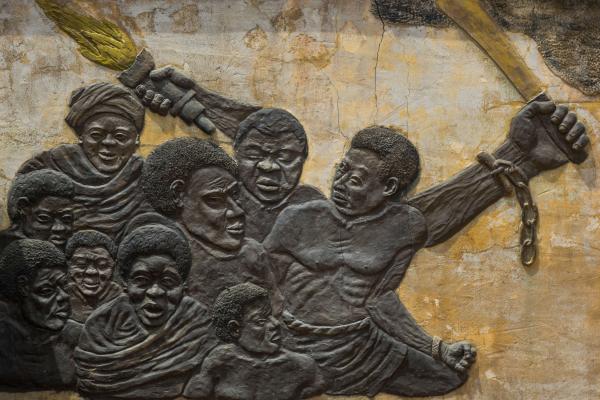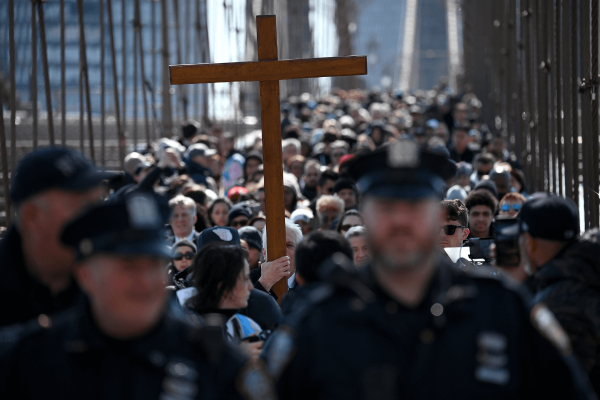Since September 2020, at least 783 local, state, and federal measures across the United States have aimed to restrict the ability to speak truthfully about race, racism, and systemic racism. The data for this chilling trend has been collected by CRT Forward, an initiative of the Critical Race Studies Program at UCLA School of Law.
In 2021, Texas, where I currently live, passed a law banning any teaching in which “slavery and racism are anything other than deviations from, betrayals of, or failures to live up to the authentic founding principles of the United States, which include liberty and equality.” It’s no secret that the Republican activists and lawmakers behind these draconian efforts are supported by a conservative, Christian base.
Ironically, though, this politically correct approach to history makes it impossible to understand both the history of the United States and the history of Christianity.
Although there’s been fierce debate about slavery’s stain on the founding of the U.S. and its contribution to ongoing inequalities, there’s been less attention devoted to how this debate relates to accounts of ancient slavery and the history of Christianity. A triumphalist history of the United States itself mirrors a triumphalist history of Christianity. The crucial link between the two is often missed due to a myopic American exceptionalism and the prolonged success of Christian propaganda. Just as some would restrict what can be said about this nation’s relationship to slavery, some have — consciously or subconsciously — limited what can be said about Christianity’s entanglement with slavery. But revisiting the long history of Christianity and slavery can challenge assumptions that people bring into discussions about racism in the present. It also shows how the ideal of freedom can be built by restricting it for others.
***
Some books utterly disrupt you. I was doing research for an essay on St. Augustine and slavery when I first came across humanities scholar Jennifer Glancy’s Slavery in Early Christianity. Reading this book made me realize that everything I thought I knew about the history of Christianity and slavery was wrong.
Deftly maneuvering between biblical texts, material evidence, and the literary and philosophical currents of the Greco-Roman world, Glancy situated early Christian slavery in its broader cultural setting. In many ways, Slavery in Christianity, which was first published in 2002 and republished this month in expanded edition, was a book ahead of its time and it has only gained relevance. I still consider it the best accessible resource for understanding the centrality of enslaved people and slaveholders within early Christian circles.
Scholars have traditionally told two faulty stories about early Christianity and slavery. According to the story of amelioration, Christianity didn’t overtly oppose slavery at first, but it created communities and promulgated teachings that humanized slaves. The growth of the Christian population within the Roman Empire gradually improved conditions for slaves and, ultimately, led to the decline of slavery as an institution.
This tale of Christianity’s rise is sometimes substituted by another tale about Christianity’s fall. According to the golden age story, Christianity began as a radically egalitarian movement opposed to slavery, but it became co-opted by the temptations of political power ushered in by the fourth-century Roman Emperor Constantine. In other words, Jesus and his earliest followers were basically social justice warriors betrayed by an emerging establishment Christianity that accommodated itself to slavery. Ascent and decline have been the prisms through which the history of early Christianity and slavery has been narrated, with the suppression, denial, mistranslation, and distortion of any evidence that seemed to suggest the contrary.
Glancy’s book systemically overturns both traditional stories told about early Christianity and slavery by carefully considering the sources available to us. For example, she highlights how early Christian slaveowners made metal collars, with clear Christian symbols, that were meant to be worn by enslaved people who might run away from their masters. “So discomforting are these objects,” Glancy writes, “that nineteenth-century scholars described them as dog collars rather than acknowledge that ancient Christians regularly bound other persons in such a crude manner.”
Another important topic addressed is the slaves found in Jesus’ parables. Previous translators and scholars have either minimized the presence of slaves as slaves in the parables or wrongly reduced the parables’ slaves as a subset of patron-client relations. Glancy diligently walks the reader through the parables of Jesus, demonstrating how the bodies of slaves are consistently vulnerable to corporal discipline and abuse. She also compares the writings of the apostle Paul with his contemporary Stoic and Cynic philosophers. It turns out he wasn’t the only one making a strong allegorical use of slaves in discussions of freedom while leaving the actual practice of slavery intact.
Many have emphasized that slavery in the Roman Empire wasn’t as bad as American slavery. After all, the argument goes, the former wasn’t based on modern race; slaves could sometimes “purchase” their freedom, and free people would sometimes willingly sell themselves into slavery. It’s true the two systems weren’t identical. But both were brutal in their own ways.
In the Roman Empire, enslaved people were reduced to things, to bodily appendages or tools of the master. They had no personal rights, owned no property, and weren’t allowed to legally marry other slaves. It’s pointless to attempt a comparison of Roman and American slavery as if a hierarchy of oppression could be established by quantifying the average rate of whip lashings. The reality, as will quickly become clear to anyone who reads Slavery in Early Christianity, is that the ancient Roman world violently dominated and dishonored enslaved people. They were regarded as objects who served the desires and needs of their superiors: Masters could buy them, sell them, inflict corporal punishment, and sexually exploit them at will. As the first-century Roman author Pliny the Elder put it: “We use other people’s feet when we go out, we use other people’s eyes to recognize things, we use another person’s memory to greet people, we use someone else’s help to stay alive…”
Perhaps the boldest question raised in the book is this: Were Christian men actually punished by the early church for sexually exploiting enslaved people in their households? Glancy’s line of reasoning upends the commonplace assumption that the moral codes and sexual ethics found in the New Testament were meant to equally apply to everyone, whether they were enslaved or free.
What makes Slavery in Early Christianity courageous, and keeps it feeling fresh today, is the questions that it asks about gender, race, and power. Glancy wasn’t afraid to put New Testament scholarship in dialogue with thinkers such as the novelist Toni Morrison. For example, the idea of enslaved bodies functioning as surrogate selves for slaveholders, as canvasses by which they could imagine their freedom, is helpful for understanding the Bible as well as American literature. Historically, questions about gender and slavery were often marginalized by academic and ecclesial gatekeepers. Glancy’s book demonstrates how often it is, indeed, the forgotten “peripheral” characters who are essential to understanding the construction of the “center.”
Every other day, it seems, there is a new article or book documenting the complicity of a modern Christian school or church with the practice of slavery. Yet, there’s been little attention devoted to how these debates and findings relate to accounts of ancient slavery. The inertia of scholarship and Christian teaching has stressed discontinuity; discontinuity between early Christians and their contemporaries; discontinuity between slavery back then and the modern U.S. slavery we’re more accustomed to discussing. The brilliance of Glancy’s gambit was to run against this stream and to consider the opposite. If there was and is continuity, then what can we learn?
Acknowledging that the Declaration of Independence was a slaveholder’s document isn’t about being “unpatriotic,” “hating your country,” or locking our society within a hopeless, fallen genealogy. In other words, we’re not simply doomed to repeat the worst reflexes of a checkered legacy. The story doesn’t end there because people deprived of their freedom used this very document to defend their rights. They elevated democracy beyond what the founders could even imagine. I think something similar could be said about Christianity and its early acceptance of slavery. Lying about this past won’t help us understand the present or build a better future.
Editor’s note: This essay is an adaptation from the foreword of Slavery in Early Christianity. It has been adapted with the permission of Fortress Press.
Got something to say about what you're reading? We value your feedback!







